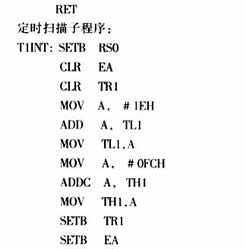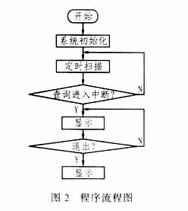In single-chip microcomputer application systems, low-cost and flexible-configuration digital tubes (LEDs) are commonly used as displays. Commonly used are 4 to 8-digit eight-segment LED digital tube displays, which require 4 to 8 LED digital tubes. There are many ways to achieve this kind of display, but corresponding measures must be taken to achieve the display of multiple LEDs. This article introduces a design method. The multi-channel LED digital tube display system designed by this method has the characteristics of simple hardware equipment, good portability and low cost, and has good application effects in various instrument display systems.
1
When the hardware circuit displays multiple LEDs, the segment selection lines of all the bits are often connected in parallel and controlled by an 8-bit I/O port, while the common cathode point or common anode point is controlled by another 8-bit I/O port. ; Parallel expansion ports can also be used to form display circuits. Usually, more pins of expansion devices are required and the price is higher. This article will introduce a simple method of using a parallel I/O port of a microcontroller to realize multiple LED displays. Figure 1 shows the hardware schematic diagram of the circuit. Among them, 74LS138 is a 3-line to 8-line decoder, 74LS164 is an 8-bit parallel output gated serial input shift register, and the LED uses L05F type common cathode digital tube.
When displaying, the display data is sent from the P12 port output of 89C52 to the A and B terminals of the shift register 74LS164 in a serial manner, and then the parallel data is output from the output terminals Q0~Q7 to control the switch tubes WT1~WT8 collector, and then send the output LED segment selection code to the digital tube LED1~LED8 at the same time. The bit selection code is output from the P14~P16 ports of the 89C52 and sent to the base of the switch tubes Y1~Y8 through the decoder 74LS138 to control the bit selection of the digital tubes LED1~LED8. In this way, the eight digital tubes are controlled by 100ms. Time intervals are displayed in rotation. Due to the residual effect of the human eye, these eight digital tubes appear to be displayed almost simultaneously.


2 Software Programming
The software programming of this system is completed using the MCS-51 series microcontroller assembly language, and the display program is used as a subroutine, so that the main program can conveniently call it. Figure 2 shows its flow chart. The specific program coding is as follows:







3 Conclusion
This design method has been used many times in the display circuits of students' microcontroller experiments and in various instrument display systems. As long as the display program is transferred into other main programs, the display function can be completed. After repeated use, it has been proven that this method has good portability and strong practicability.
Reference address:Microcontroller 89C52 parallel I/O port realizes multiple LED displays
1
When the hardware circuit displays multiple LEDs, the segment selection lines of all the bits are often connected in parallel and controlled by an 8-bit I/O port, while the common cathode point or common anode point is controlled by another 8-bit I/O port. ; Parallel expansion ports can also be used to form display circuits. Usually, more pins of expansion devices are required and the price is higher. This article will introduce a simple method of using a parallel I/O port of a microcontroller to realize multiple LED displays. Figure 1 shows the hardware schematic diagram of the circuit. Among them, 74LS138 is a 3-line to 8-line decoder, 74LS164 is an 8-bit parallel output gated serial input shift register, and the LED uses L05F type common cathode digital tube.
When displaying, the display data is sent from the P12 port output of 89C52 to the A and B terminals of the shift register 74LS164 in a serial manner, and then the parallel data is output from the output terminals Q0~Q7 to control the switch tubes WT1~WT8 collector, and then send the output LED segment selection code to the digital tube LED1~LED8 at the same time. The bit selection code is output from the P14~P16 ports of the 89C52 and sent to the base of the switch tubes Y1~Y8 through the decoder 74LS138 to control the bit selection of the digital tubes LED1~LED8. In this way, the eight digital tubes are controlled by 100ms. Time intervals are displayed in rotation. Due to the residual effect of the human eye, these eight digital tubes appear to be displayed almost simultaneously.


2 Software Programming
The software programming of this system is completed using the MCS-51 series microcontroller assembly language, and the display program is used as a subroutine, so that the main program can conveniently call it. Figure 2 shows its flow chart. The specific program coding is as follows:







3 Conclusion
This design method has been used many times in the display circuits of students' microcontroller experiments and in various instrument display systems. As long as the display program is transferred into other main programs, the display function can be completed. After repeated use, it has been proven that this method has good portability and strong practicability.
Previous article:Integrated power stage LED and constant current source circuit integrated design
Next article:Discussion and experiment on the application of integrated audio power amplifier IC to BTL
- Popular Resources
- Popular amplifiers
Latest Power Management Articles
- MathWorks and NXP Collaborate to Launch Model-Based Design Toolbox for Battery Management Systems
- STMicroelectronics' advanced galvanically isolated gate driver STGAP3S provides flexible protection for IGBTs and SiC MOSFETs
- New diaphragm-free solid-state lithium battery technology is launched: the distance between the positive and negative electrodes is less than 0.000001 meters
- [“Source” Observe the Autumn Series] Application and testing of the next generation of semiconductor gallium oxide device photodetectors
- 采用自主设计封装,绝缘电阻显著提高!ROHM开发出更高电压xEV系统的SiC肖特基势垒二极管
- Will GaN replace SiC? PI's disruptive 1700V InnoMux2 is here to demonstrate
- From Isolation to the Third and a Half Generation: Understanding Naxinwei's Gate Driver IC in One Article
- The appeal of 48 V technology: importance, benefits and key factors in system-level applications
- Important breakthrough in recycling of used lithium-ion batteries
MoreSelected Circuit Diagrams
MorePopular Articles
- Innolux's intelligent steer-by-wire solution makes cars smarter and safer
- 8051 MCU - Parity Check
- How to efficiently balance the sensitivity of tactile sensing interfaces
- What should I do if the servo motor shakes? What causes the servo motor to shake quickly?
- 【Brushless Motor】Analysis of three-phase BLDC motor and sharing of two popular development boards
- Midea Industrial Technology's subsidiaries Clou Electronics and Hekang New Energy jointly appeared at the Munich Battery Energy Storage Exhibition and Solar Energy Exhibition
- Guoxin Sichen | Application of ferroelectric memory PB85RS2MC in power battery management, with a capacity of 2M
- Analysis of common faults of frequency converter
- In a head-on competition with Qualcomm, what kind of cockpit products has Intel come up with?
- Dalian Rongke's all-vanadium liquid flow battery energy storage equipment industrialization project has entered the sprint stage before production
MoreDaily News
- Allegro MicroSystems Introduces Advanced Magnetic and Inductive Position Sensing Solutions at Electronica 2024
- Car key in the left hand, liveness detection radar in the right hand, UWB is imperative for cars!
- After a decade of rapid development, domestic CIS has entered the market
- Aegis Dagger Battery + Thor EM-i Super Hybrid, Geely New Energy has thrown out two "king bombs"
- A brief discussion on functional safety - fault, error, and failure
- In the smart car 2.0 cycle, these core industry chains are facing major opportunities!
- The United States and Japan are developing new batteries. CATL faces challenges? How should China's new energy battery industry respond?
- Murata launches high-precision 6-axis inertial sensor for automobiles
- Ford patents pre-charge alarm to help save costs and respond to emergencies
- New real-time microcontroller system from Texas Instruments enables smarter processing in automotive and industrial applications
Guess you like
- MSP430 digital tube display problem
- About ARM's interrupt service routine
- Study stickers
- Advanced usage of embedded C language
- [Evaluation of EVAL-M3-TS6-665PN development board] 2. Detailed explanation of functions
- I can't understand the circuit diagram at all
- What software is used for high-speed PCB design analysis
- MSP430F149 key detection program
- STEVAL-IDB0071V1_ by gs001588
- Proteus 8.9 supports STM32F401

 A review of learning-based camera and lidar simulation methods for autonomous driving systems
A review of learning-based camera and lidar simulation methods for autonomous driving systems Visual ModelQ V7
Visual ModelQ V7











 京公网安备 11010802033920号
京公网安备 11010802033920号